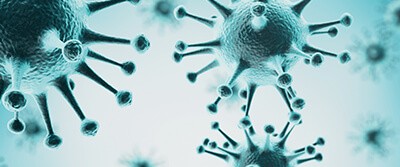Viruses Are Capable of Gene Transfers

By Horace Jenkins
A recent study showed that viruses can share genes with cells that are not their typical hosts. As reported in the journal Frontiers in Microbiology, this new information contributes to the ever-mounting evidence that viruses are able to interchange genes with a variety of cellular organisms.
The Evolution of Viruses
Viruses have historically been known to infect or interact with organisms within only one of the three taxonomy domains or superkingdoms: Archaea, Bacteria and Eukarya. (The first two include only prokaryotic or single-celled organisms; the latter includes animals, plants, fungi and protists.) While it has long been understood that viruses can move or “jump” between hosts — like HIV, which jumped from chimpanzees to humans — viruses had not been known to interact with organisms across superkingdoms.
“Normally, we associate viruses with very specific host organisms, and we do not know of any virus that, for example, can infect both bacteria and humans,” said Arshan Nasir, PhD, an assistant professor of biosciences at COMSATS Institute of Information Technology, Islamabad, Pakistan, and one of the study's authors. “Virus–host boundaries make sense since organisms that are separated by large evolutionary distances differ starkly in their cellular biology. This makes it hard for a virus to successfully replicate inside two very diverse environments.”
Sharing Genetic Materials
Virus–host affiliations can be studied by observing the cytopathic effects of a viral infection or through the microscopic detection of virions (independent viral particles). In addition to the lytic mode of viral reproduction, whereby the virus replicates within and then ruptures the host cell, viruses can also integrate their genetic material into a cell’s genome.
Dr. Nasir and his colleagues have considered the possibility that leaps between distant species may occur, but they had not entertained the possibility that such leaps might involve viral interactions. “In addition to infecting and killing cells, viruses can also insert their genes into a cell's DNA,” Dr. Nasir said. “We therefore hypothesized that viruses might interact in non-harmful ways to exchange genes between distantly related organisms.”
To properly examine this particular type of viral gene exchange, Nasir and his colleagues studied the range of protein structures found in all identified viruses and cellular organisms. By focusing on protein structures that are exclusively linked to viruses or cells, the researchers were able to identify virus-derived genes in cellular organisms and cell-derived genes in viruses. The research team also discovered evidence that suggests viruses and cellular organisms share a massive group of protein structures that support cell functionality.
The Potential for a New Perspective
In time, Nasir believes that these results may change the way we view virus–host relationships. “We should consider viruses to be a source of new genes that cellular organisms can acquire,” he said, “and not necessarily just as a source of disease.”
Discussion Questions
- Discuss virus forms and activities.
- What other human viral diseases exist because of a “jump” from another host?
Vocabulary
- Virus
- DNA
- Gene

